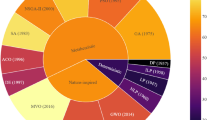Abstract
Hybrid gas turbine–solid oxide fuel cell power generation has the potential to create a positive economic and environmental impact. Annually, the U.S. spends over $235 billion on electricity, and electric utilities emit 550 million metric tons of carbon. The integration of distributed hybrid generation can reduce these emissions and costs through increased efficiencies. In this paper, a model is presented that minimizes the costs of distributed hybrid generation while optimally locating the units within the existing electric infrastructure. The model utilizes data from hybrid generation modules, and includes uncertainty in customer demand, weather, and fuel costs.
Similar content being viewed by others
References
Appleby, A.J. (1993). "Characteristics of Fuel Cell Systems." In L. Blomen and M. Mugerwa (eds.), Fuel Cell Systems. New York: Plenum Press.
Benders, J.F. (1962). "Partitioning Procedures for Solving Mixed Variables Programming Problems." Nu-merische Mathematics 4, 238–252.
Birge, J.R. and F.V. Louveaux. (1988). "A Multicut Algorithm for Two-Stage Stochastic Linear Programs." European Journal of Operational Research 34(3), 384–392.
Birge, J.R. and F.V. Louveaux. (1997). Introduction to Stochastic Programming.New York: Springer.
Bramel, J. and D. Simchi-Levi. (1997). The Logic of Logistics.New York: Springer.
str/regmap.html}
Dicks, A.L. and P.A. Martin. (1998). "A Fuel Cell Balance of Plant Test Facility." Journal of Power Sources 71(1-2), 321–327.
Dunn, R. (2001). "Table 17." In Annual Electric Utility Data. Energy Information Administration, http: //www.eia.doe.gov/cneaf/electricity/esr/esrtl7pl6.html
Energy Information Administration. (1997). "Emissions of Greenhouse Gases." DOE/EIA-0573(96), Washington, DC.
Energy Information Administration. (1999). "Annual Energy Review." DOE/EIA-0384(99), Washington, DC.
Energy Information Administration. (2000). "Emissions of Greenhouse Gases in the United States." DOE/EIA-0573(99), Washington, DC.
Forbes, C.A. (2001). "Siemens Westinghouse Power Corporation." Personal communication.
Gassmann, H.I. (1990). "MSLiP: A Computer Code for the Multistage Stochastic Linear Programming Problem." Mathematical Programming 47, 407–423.
Ghiocel, D.M. and N.F. Rieger. (1999). "Probabilistic High Cycle Fatigue Life Prediction for Gas Turbine Engine Blades." In Proceedings of the 1999 Structures, Structural Dynamics, and Materials Conference, Vol. 4, pp. 2980–2989.
Haynes, C. and W. Wepfer. (2000). "Enhancing Fuel Cell/Gas Turbine Hybrid Power Systems via Reduced Fuel Utilization." In Proceedings of the ASME AESD, Vol. 40, pp. 311–328. AES.
Hoffman, P., D. Haught, T. Sebestyen, and T. King. (1999). "Distributed Generation." Office of Industrial Technologies, Department of Energy.
ILOG Corporation. (2001). "CPLEX7.0." Incline Village, NV: ILOG Corporation.
Inaba, M., A. Mineshige, T. Maeda, S. Nakanishi, T. Ioroi, T. Takahashi, A. Tasaka, K. Kikuchi, and Z. Ogumi. (1997). "Growth Rate of Yttria-Stabilized Zirconia Thin Films Formed by Electrochemi-cal Vapour-Deposition Using NiO as an Oxygen Source." Solid State Ionics, Diffusion and Reactions 104(3-4), 303–310.
Ippommatsu, M., H. Sasaki, and S. Otoshi. (1996). "Evaluation of the Cost Performance of the SOFC Cell in the Market." International Journal of Hydrogen Energy 21(2), 129–135.
Itoh, H., M. Mori, N. Mori, and T. Abe. (1994). "Production Cost Estimation of Solid Oxide Fuel Cells." Journal of Power Sources 49(1-3), 315–332.
Jacard, M., A. Bailie, and J. Nyboer. (1996). "CO 2 Emission Reduction Costs in the Residential Sector." Energy 17(4), 107–134.
pa.html}
Khandkar, A., J. Hartvigsen, and S. Elangovan. (2000). "A Techno-Economic Model for SOFC Power Systems." Solid State Ionics 135, 325–330.
Kincaid, D.E. (1999). "The Role of Distributed Generation in Competitive Energy Markets." In Distributed Generation Forum, Gas Research Institute.
Lundberg, W.L., R.A. Holmes, J.E. King, G.A. Israelson, P.R. Zafred, R.E. Kothmann, M.D. Moeckel, and S.E. Veyo. (2001). "A High Efficiency PSOFC/ATC-Gas Turbine Power System: Final Report." PD-99-118A, Department of Energy.
MacKerron, G. (2000). "Financial Considerations of Exploiting Fuel Cell Technology." Journal of Power Sources 86, 28–33.
Manninen, J. and X.X. Zhu. (1999). "Optimal Gas Turbine Integration to the Process Industries." Industrial and Engineering Chemistry Research 38, 4317–4329.
Mirchandani, P.B. and R.L. Francis. (1990). Discrete Location Theory.New York: Wiley.
National Energy Technology Laboratory. (2001). "Hybrid Fuel Cell Technology Overview." DOE/NETL-2001/ 1145, Department of Energy.
power/distributed_power.html}
Passel, P. (1997). "How Fast to Cut Back." New York Times 12/1, GW.8.
Perritt, D. (2002). "Monthly Energy Review." Energy Information Administration, http://www.eia. doe.gov/emeu/mer/
Rastler, D. (2002). "Market Assessment and Opportunities for Fuel Cell Hybrids." In 2nd DOE/UN International Conference and Workshop on Hybrid Power Systems, Charlotte, NC.
Riensche, E., U. Stimmung, and G. Unverzagt. (1998). "Optimization of a 200 kW SOFC Cogeneration Power Plant: Part I." Journal of Power Sources 73, 251–256.
Schnapp, R.M. and B. Quade. (2001). "Table A.6." In Electric Power Annual, Vol. 1, http://www.eia. doe.gov/cneaf/electricity/epavl/ta6pl.html
Shapiro, K.G. (2001). "Incorporating Costs in LCA." International Journal of Life Cycle Assessment 6(2), 121–123.
Singhal, S.C. (1998). "Application of Ionic and Electronic Conducting Ceramics in Solid Oxide Fuel Cells." In Proceedings of the 3rd International Symposium on Ionic and Mixed Conducting Ceramics, pp. 125–136.
Smith, J.C., A.J. Schaefer, and J. Yen. (2002). "A Stochastic Intra-Ring Synchronous Optical Network Design Problem." Stochastic Programming E-Print Series.
Tanaka, K., C. Wen, and K. Yamada. (2000). "Design and Evaluation of Combined Cycle System with Solid Oxide Fuel Cell and Gas Turbine." Fuel 79, 1493–1507.
Tryon, R.G. and T.A. Cruse. (2000). "Probabilistic Mesomechanics for High Cycle Fatigue Life Prediction." Journal of Engineering Materials and Technology 122(2), 209–214.
Van Slyke, R. and R.J.-B. Wets. (1969). "L-Shaped Linear Programs with Applications to Optimal Control and Stochastic Programming." SIAM Journal on Applied Mathematics 17, 638–663.
bro.pdf}
Yokokawa, H., N. Sakai, T. Horita, and K. Yamaji. (2001). "Recent Developments in Solid Oxide Fuel Cell Materials." Fuel Cells 1(2), 117–131.
Author information
Authors and Affiliations
Rights and permissions
About this article
Cite this article
Schaefer, L.A., Schaefer, A.J. Locating Hybrid Fuel Cell–Turbine Power Generation Units under Uncertainty. Ann Oper Res 132, 301–322 (2004). https://doi.org/10.1023/B:ANOR.0000045288.72359.de
Issue Date:
DOI: https://doi.org/10.1023/B:ANOR.0000045288.72359.de




